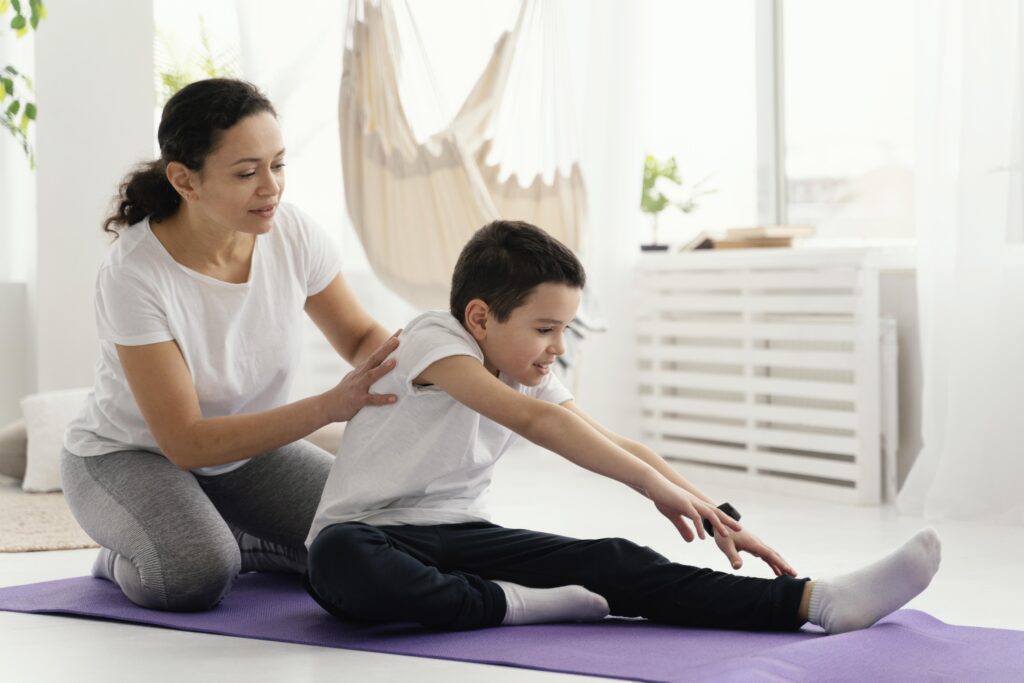Autism spectrum disorder (ASD) is a neurodevelopmental condition characterized by challenges in social communication, restricted interests, and repetitive behaviors. While conventional therapies like Applied Behavior Analysis (ABA) and speech therapy are widely used, complementary approaches such as yoga and lifestyle medicine are gaining recognition for their ability to address core symptoms and improve overall well-being.
The Role of Yoga in Autism Management
Yoga, as a holistic mind-body intervention, has shown significant promise in improving behavioral, emotional, and physical outcomes in individuals with ASD. It integrates physical postures (asanas), breathing exercises (pranayama), chanting, mindfulness, and relaxation to create a structured therapeutic experience.
Benefits of Yoga for Autism
- Reduction in Problem Behaviors: Yoga interventions have been shown to reduce irritability, hyperactivity, and self-stimulatory behaviors. A study involving 12 weeks of yoga in special schools demonstrated significant reductions in autism severity compared to control groups (P < 0.001)1.
- Improved Motor Coordination: Yoga enhances motor planning, balance, and proprioception. For example, an 8-week yoga program showed improvements in static and dynamic balance as well as ball skills2.
- Emotional Regulation: Breathing exercises and relaxation techniques activate the parasympathetic nervous system, reducing stress and anxiety while promoting calmness24.
- Social Skills Development: Partner yoga and group sessions improve imitation, eye contact, communication skills, and emotional bonding35.
- Sensory Integration: Repetitive postures and mindful breathing improve sensory processing and reduce sensory defensiveness47.
Mechanisms Behind Yoga’s Effectiveness
- Neurological Activation:
- Guided imitation of therapist movements during yoga may stimulate mirror neuron activation, improving self-awareness and imitation skills critical for social interaction3.
- Enhanced sensory integration through motor-sensory stimulation leads to better attention regulation and reduced repetitive behaviors47.
- Physiological Changes:
- Activation of the parasympathetic nervous system lowers cortisol levels, reducing stress responses.
- Improved heart rate variability correlates with better spatial perception, verbal receptivity, and emotional regulation4.
- Behavioral Modulation:
- Structured routines in yoga help reduce maladaptive behaviors while fostering adaptive responses to sensory stimuli.
- Social-Emotional Development:
- Interactive poses encourage teamwork, tolerance to social stimuli, and emotional bonding with peers or family members.
Lifestyle Medicine for Autism
Lifestyle medicine complements yoga by addressing co-occurring conditions like obesity, anxiety, or ADHD through diet, exercise, sleep hygiene, and stress management.
Key Components
- Physical Activity:
- Regular exercise improves executive function and emotional resilience while reducing anxiety.
- Structured activities like yoga or aerobic exercises enhance motor coordination and reduce sedentary behavior2.
- Nutrition:
- A Mediterranean diet rich in whole grains, fruits, vegetables, healthy fats, and lean proteins supports metabolic health.
- Balanced nutrition reduces inflammation linked to ASD symptoms.
- Mindfulness Practices:
- Meditation techniques improve focus and reduce hyperactivity by enhancing attention control.
Evidence Supporting Yoga for Autism
- A randomized controlled trial (RCT) involving 43 children with ASD found that a 12-week yoga program significantly reduced autism severity scores compared to a control group1.
- Another study demonstrated that an 8-week yoga intervention improved motor coordination (e.g., balance) while reducing problem behaviors like irritability2.
- Long-term participation in yoga has been associated with better sensory integration, emotional regulation, and verbal receptivity34.
Yoga4Autism Program
The Yoga4Autism program is a structured intervention tailored specifically for children with ASD. It incorporates modified poses, breathing exercises, relaxation techniques, and group activities to address core symptoms effectively.
Structure of the Program
- Warm-Up:
- Poses: Cat pose (Marjaryasana), mountain pose (Tadasana), chair pose (Utkatasana).
- Purpose: Prepares the body by enhancing flexibility and reducing tension.
- Asana Strengthening:
- Poses: Downward dog pose (Adho Mukha Svanasana), tree pose (Vrikshasana).
- Purpose: Improves motor coordination, balance, and body awareness.
- Relaxation & Cool-Down:
- Poses: Child’s pose (Balasana), butterfly pose (Baddha Konasana), seated forward bend pose (Paschimottanasana).
- Purpose: Promotes calmness by activating the parasympathetic nervous system.
Additional Components
- Breathing Exercises: Techniques like alternate nostril breathing (Nadi Shodhana) regulate stress responses.
- Chanting & Vocalization: Chanting “Om” improves auditory processing while calming the mind.
- Partner Yoga/Group Activities: Encourages social interaction through shared poses.
Evidence from Yoga4Autism
A 12-week implementation of this program in special schools resulted in significant improvements in social communication skills, motor coordination, sensory integration, and reductions in problem behaviors12.
Conclusion
Yoga combined with lifestyle medicine offers a holistic approach to managing autism spectrum disorder by addressing core symptoms through physiological regulation and behavioral adaptation. Programs like Yoga4Autism provide structured interventions that promote long-term benefits for children with ASD when integrated into broader therapeutic plans.
Citations:
- https://pmc.ncbi.nlm.nih.gov/articles/PMC9678151/
- https://pmc.ncbi.nlm.nih.gov/articles/PMC10886297/
- https://pmc.ncbi.nlm.nih.gov/articles/PMC3151379/
- https://journals.lww.com/yomi/fulltext/2019/51010/yoga_as_a_therapeutic_tool_in_autism__a_detailed.2.aspx
- https://digitalcommons.pepperdine.edu/cgi/viewcontent.cgi?article=1618&context=etd
- https://yogainternational.com/ecourse/understanding-autism-spectrum-disorder-a-course-for-yoga-teachers/
- https://www.semanticscholar.org/paper/Yoga-as-a-therapeutic-tool-in-autism:-A-detailed-Artchoudane-Bhavanani/e12a49fed15022655d7f848922438839925135dc
- https://pmc.ncbi.nlm.nih.gov/articles/PMC10124171/

